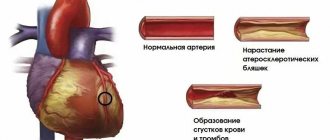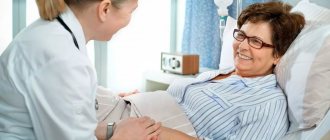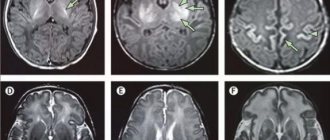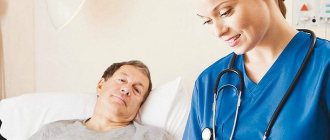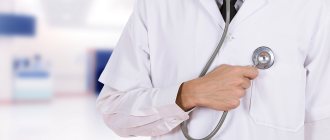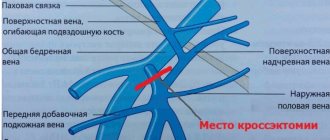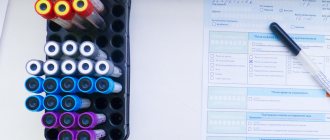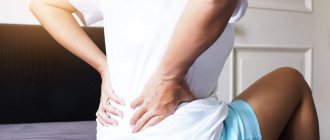A microstroke is microdamage and disruption of the brain as a result of lack of oxygen; the first bell before a stroke. It does not cause significant harm, but is an indicator of various disorders. At the same time, doctors generally do not call such a disease as a microstroke; now they are increasingly inclined to think that this is the same stroke (only in a mild form) or a transient cerebrovascular accident. But, no matter what we call this disease, the fact is a fact: it exists, affects people and has its consequences.
Differences between a minor stroke and an ischemic one
In fact, in terms of symptoms, these two diseases are quite similar (even to diagnose a microstroke at home, the patient needs, for example, to try to raise both arms; the same exercise is used for stroke). They are distinguished only by their duration (a ministroke comes and goes quickly) and the consequences for the body (a minor stroke can go away on its own, without medical intervention). But the diagnostic and treatment methods are the same, because usually a microstroke foreshadows the onset of an ischemic one.
Make an appointment
Possible manifestations: numbness and immobilization of one half of the face, unsteadiness of gait, severe headache, dizziness. Symptoms can be isolated or combined. With microstrokes, the symptoms disappear within 24 hours.
Introduction
Against the background of high blood pressure, the patient develops various neurological symptoms. They are not as pronounced as during a stroke, and last no more than a day. In some people, a micro-stroke goes unnoticed; patients attribute the malaise to weather sensitivity or nervous shock.
The main danger of a TIA is the possibility of recurrence in the future. Damage to the blood vessels of the heart and kidneys occurs, and the threat of developing a real attack with paralysis becomes real. Rehabilitation after a mini-stroke begins in a hospital and continues at home.
To restore neurological functions, the following are used:
- medicines;
- physical exercise;
- physiotherapeutic methods;
- diet;
- massage;
- breathing exercises;
- classes with a speech therapist and psychotherapist.
Myths about microstroke
Many of us have heard the name “ministroke,” but not everyone knows what it is and why this condition is dangerous.
To begin with, we note that, at the same time, it is necessary to distinguish between this condition and a stroke, and not.
Why?
- A disease that doesn't exist? Experts do not separately identify such a disease as microstroke. In the medical lexicon, this is called transient cerebrovascular accident (TCI);
- "Micro" disease? The prefix “micro” in the word is only misleading: it does not mean at all that there is no need to be afraid of this condition or that there is no need to take urgent measures to eliminate it; rather, on the contrary, it emphasizes the “kinship” with stroke with only one difference - in symptoms. The symptoms of a minor stroke are not as severe as those of a cerebral hemorrhage, and they go away much faster.
- Is it possible to recover? After a mini-stroke, the body can often recover without the help of a doctor, but it is still worth getting examined: even if the symptoms have already disappeared, the specialist should know that they were there. Thus, it is more likely that relapses and strokes will be prevented.
The “micro” in the word does not make this disease insignificant, it only hints that the disease is reversible (unlike a full-blown stroke). Therefore, diagnosis and treatment should be approached with full responsibility. So what myths about microstroke are just myths and should not be believed?
- Minor stroke is a rare disease. Unfortunately, it is not. Every year it affects tens of thousands of people, and many of them, without proper treatment, lead to disability.
- Only old people can get sick. Unfortunately no. This disease increasingly affects people aged 20-30 years. True, a young body usually fights the consequences better than an older person’s body, but that’s another story.
- What can happen cannot be avoided: a stroke cannot be prevented. This is also a myth. There are certain preventive measures that can help avoid encountering this unpleasant disease.
- A microstroke cannot be recognized: the symptoms are too mild. In part, this is not a myth; the symptoms are really mild. But if you have the signs described above, the time-tested exercise “raise both arms up” is suitable - one part fails during a microstroke, so the patient can only raise one arm.
- Micro-stroke, stroke and heart attack are the same thing. If we mentioned the differences between the first two diseases above, then the third differs from both of them in location. A heart attack is located in the heart, while a (micro)stroke is located in the brain.
Diagnosis of microstroke at the Yusupov Hospital is carried out using modern medical equipment. European CT and MRI installations make it possible to accurately determine the location of the lesion and its extent. An individual treatment and rehabilitation program is developed for each patient. The recovery period takes place under the supervision of experienced neurologists, massage therapists, exercise therapy instructors and physiotherapists. A personal approach can reduce the time of hospital stay and reduce the risk of recurrent microstroke.
Causes of microstroke
- Atherosclerosis (in this case, the cause of the disease is a plaque in the vessels, which either comes off or sticks to the wall of the vessel: both lead to obstruction of blood through the vessel);
- Thrombosis - separation of a blood clot, disruption of the nutrition of neurons in the lower extremities;
- Vascular spasm, as a result of which blood does not flow to the brain;
- Anemia - a drop in hemoglobin levels, a decrease in oxygen levels in the brain;
- Increased blood viscosity (usually due to chronic diseases, polycythemia, insufficient fluid intake);
- High blood pressure;
- Obesity (there is an increased load on the heart when the body has extra pounds);
- Hereditary brain pathologies;
- Heart attack and other heart diseases that weaken it;
- Previous heart surgery;
- Stress (provokes increased blood pressure);
- Age (despite the fact that this disease is getting younger, more often older people still suffer from it, since their blood vessels are worn out);
- Abrupt climate change (more than 10 degrees).
What is a microstroke and how to treat it?
Before we understand this concept, let's first define what a stroke itself is. They talk about it when there is a sudden disruption of the blood supply to a certain area of the brain, which leads to a neurological defect. A microstroke means about the same thing, only to a reduced extent.
What are the main causes of microstroke?
The occurrence of a micro-stroke is usually facilitated by such factors as prolonged overexertion, overwork and insomnia, however, by themselves they cannot lead to this disease; there must be compelling reasons, which, for example, include:
- cerebral atherosclerosis;
- hypertension or attacks of significantly increased blood pressure;
- various types of arrhythmias;
- diabetes mellitus, in which the vascular wall is often damaged, and it can very easily rupture and lead to hemorrhage in the brain.
How does this pathological condition manifest itself?
Symptoms of a mini-stroke may vary in different situations. It depends on which part of the brain the hemorrhage occurred in or in which vessel the blood clot settled, causing tissue ischemia. Usually the onset is spontaneous - a person complains of headache, dizziness, irritability, and a negative reaction to light and sound stimuli. Vomiting often occurs, limbs become numb, a feeling of weakness in the muscles of the legs or arms, and goosebumps crawling on the skin. Speech and movement disorders and impaired coordination of movements may also appear. If you measure your blood pressure at this moment, it will almost always be greatly elevated.
The main difference between a microstroke and its older counterpart is the transient nature of the symptoms (transient). All symptoms of a microstroke should go away within 24 hours. It turns out that his diagnosis is made retroactively. If the above symptoms persist to some extent after 24 hours, then the patient has had a real stroke.
How to diagnose and how to treat a microstroke?
Research methods such as ultrasound with a Doppler ultrasound sensor and a duplex scanning apparatus have proven themselves well in diagnosing this pathological condition. With their help, it is possible to most reliably assess the degree and quality of blood flow in the basin of a particular cerebral artery. These methods are also applicable to the vessels of the neck. They accurately identify the area where a blood clot has blocked a vessel and caused ischemia of brain tissue, or the place where the wall of a vessel has burst and hemorrhage has occurred.
The treatment of a micro-stroke is no different from the treatment of a stroke, since, as already mentioned, in the first day it is impossible to distinguish between them. In this case, the main thing is to promptly seek qualified medical help. And the sooner therapeutic measures begin, the better the prognosis in the future.
First, doctors restore normal blood flow in the affected area of the brain by prescribing drugs that dilate the walls of blood vessels (pentoxifylline, nicotinic acid), destroy a blood clot (aspirin, clopidogrel), protect and strengthen the vascular wall (nimodipine). Nootropic and metabolic drugs (for example, piracetam, actovein) are also administered.
During the recovery period, you must attend therapeutic massage sessions, perform special exercises daily, and go to physical therapy.
Sometimes sessions with a speech therapist are required to restore speech skills lost due to the disease. If the patient has been bothered by a severe headache for a long time, then he is prescribed non-steroidal anti-inflammatory painkillers. In any case, to avoid recurrence of a mini-stroke, regular examination by your doctor is required. Author: K.M.N., Academician of the Russian Academy of Medical Sciences M.A. Bobyr
The first signs of a microstroke
The very first sign of a microstroke is numbness of the extremities for a short time (many patients attribute it to “numbness” of the leg or arm). Also, the first, that is, appearing earlier than others, signs of a microstroke include:
- Short painless blindness in one eye (as if a shadow had crept into the field of vision for 20-30 seconds);
- Temporary and sudden numbness of the face (the person will not be able to smile);
- Loss of the ability to speak coherently (sounds and words are confused, sometimes it is impossible to utter a word at all);
- A sharp headache (like a flash) - does not go away even if you take any medications;
- Short-term disturbances in coordination of movements are possible (objects fall from hands, the patient simply cannot lift them for some time);
- The skin becomes pale;
- Weakness appears throughout the body (a person suddenly wants to sit down or lie down);
- Sweating increases sharply for no apparent reason.
The first symptoms of a microstroke
In terms of symptoms, a microstroke is not very different from a traditional one. The most important difference is the duration of symptoms (usually no more than a few hours) and its intensity (signs are not as noticeable as with a stroke). Symptoms manifest themselves differently, depending on the location of the outbreak (the place where blood circulation is impaired):
- Occipital lobe of the brain (responsible for the perception of visual information): there is visual impairment to complete blindness in one or both eyes;
- Parietal lobe (responsible for tactile sensations): loss of smell, sensation of movement under the skin.
- Temporal lobe (responsible for hearing and memory): short-term memory and hearing loss.
- Frontal lobe (responsible for intelligence and muscle tone): paralysis, mood swings.
The body usually overcomes this condition on its own, and the brain is not seriously damaged.
As already noted, a micro-stroke often hardly manifests itself: the symptoms are very mild, which is why they are so easy to overlook. But it’s still worth paying attention to these first signs of the disease:
- Numbness of the whole body (or one part of it, so it may be impossible to smile or raise both arms);
- Dizziness;
- Severe headache;
- Double vision;
- Unsteady movements, weakness, desire to sit down or lie down.
To diagnose a microstroke at home, you can use the FAST test. It was developed in America for emergency doctors so that they could easily diagnose cerebral hemorrhage. This test is also suitable for a micro-stroke, since the symptoms (facial distortion, weakened arms and incoherent speech) are also present in this case, although they pass much faster. FAST is an abbreviation, but the word itself is translated from English as “quickly” - one of the main rules when diagnosing a disease.
F (face - “face”) - you need to pay attention to the victim’s face: it can be unnaturally skewed.
A (arms - “hands”) - the patient’s hands do not obey: they are weakened, trembling and do not rise up.
S (speech - “speech”) - words are confused, it is impossible to pronounce even a simple sentence without errors.
T (time - “time”) - time: so precious in the case of this disease. It is better to start diagnostics as soon as the first signs appear, because as soon as they pass (with a microstroke this usually takes no more than an hour or two), the patient will feel great again. But for emergency doctors, diagnosing the symptoms will help a lot.
What to do immediately after a stroke at home?
Proper recovery after a stroke at home with the support of relatives and under the supervision of doctors brings good results. It is important to start rehabilitation immediately and not to miss the “rehabilitation window” - this is the year after the stroke, when treatment gives the maximum result.
Recovery after strokes is divided into several periods; the time may shift depending on the patient’s condition.
| The most acute period | Acute period | Early recovery period | Late recovery period | Period of residual effects |
| First 5 days | 3-4 weeks | Up to 6 months | 6-12 months | After 1 year |
Find out how to get comprehensive rehabilitation at home in St. Petersburg with an effectiveness of 95% of the intended result
To know
Who does the disease affect?
This disease is getting younger and, if previously it was believed that it only affected older people, now this is not the case. Much depends on the person’s health status, lifestyle and chronic diseases.
Still, patients with the following problems are at risk:
- Atherosclerosis (chronic artery disease);
- Hypertension (pressure surges can trigger a minor stroke);
- Vascular lesions;
- Diabetes mellitus (high sugar content affects the walls of blood vessels);
- Alcohol abuse (the functionality of brain vessels decreases, toxins destroy tissue);
- Congenital and acquired heart diseases.
Busy people suffer a micro-stroke on their feet, that is, they do not pay attention to its symptoms and first signs, trying to maintain their usual activity. This should not be done under any circumstances, since within 24-48 hours there is a high risk of a stroke; the consequences in this case can be disability and even death. Therefore, a minor stroke is an indication for emergency hospitalization of the patient.
Recovery period
What is a microstroke, how to treat it - this is the paraphry of specialists. But the patient himself must understand that he will have to go through a fairly long recovery period. It is understood that the following recommendations from doctors will need to be followed:
- stick to a diet - give up alcohol and smoking, limit fatty and spicy foods;
- undergo medical examination every 2-3 years;
- normalize and strictly adhere to the daily routine;
- lead an active lifestyle and engage in basic physical education;
- regularly monitor blood pressure.
In addition, it is necessary to promptly treat coronary artery disease, hypertension, and arrhythmia. Only in this case can you be sure that a major stroke will be prevented.
Self-medication for microstroke is unacceptable! When the first signs of a sharp narrowing of the small vessels of the brain appear, it is necessary to seek qualified medical help.
Related services: Consultation with a neurologist Intensive care unit
Types of microstroke
There are three main types of microstroke:
- Hemorrhagic stroke is hemorrhage with the formation of hematomas. Recovery takes from two weeks to several months.
- Ischemic stroke leads to blockage of blood vessels by blood clots. It differs from hemorrhagic in its increasing effect. In most cases, patients are diagnosed with this type of microstroke.
- Lacunar strokes involve damage to small arteries in the brainstem or cortex.
It is important to correctly diagnose the type of microstroke in order to provide assistance to the patient. A minor stroke is dangerous because it can recur and, without proper treatment, lead to extensive hemorrhage in the brain.
Diagnosis of microstroke
Despite the fact that this disease, compared to traditional stroke, is relatively harmless, it still needs to be diagnosed and treated. Although a microstroke occurs and passes quickly, it still causes some harm to the body and in half of the cases ends in a stroke or heart attack. That's why diagnosing the disease is so important. To make a correct diagnosis, the patient is prescribed the following examinations:
- ECG and ultrasound of the heart;
- Vascular examination;
- An echocardiogram determines any abnormalities in the heart;
- Blood test for platelet count, clotting time, sugar, etc.
- CT can detect a blood clot and determine its nature.
- REG (rheographic method for studying the vascular system of the brain) and ultrasound examination (ultrasound examination) with functional tests (for example, with turns and tilts of the head) - these methods are necessary for examining the arteries of the spine.
- MRI will allow you to detect the location of the blood clot with high accuracy.
It may be necessary to involve other specialists. For example, an ophthalmologist determines the visual field and conducts an examination of the fundus.
How to treat a microstroke
To prevent the development of severe consequences, you need to know not only the signs of a microstroke, but also the rules for providing first aid to a person in a similar condition.
First aid for microstroke
At the onset of the disease, it is almost impossible to distinguish between the condition in question and a “classic” (extensive) stroke. First aid for microstroke:
- call an ambulance;
- put the patient on a hard surface, place the head on a slight elevation - this will prevent swelling of the brain tissue;
- if the patient starts vomiting, then his head should be turned to the side - this will prevent vomit from entering the respiratory tract;
- It is necessary to provide access to fresh air - unbutton your shirt, belt, collar of outerwear.
If it is possible to measure the patient’s blood pressure, then this should be done, since this data will help doctors navigate the victim’s condition.
Even if a micro-stroke occurs, first aid (pre-medical) does not imply administering medications to the patient that reduce blood pressure. Such manipulations can only be done by a specialist, since the pressure must be reduced gradually and appropriate medications administered in doses.
Treatment of microstroke
In a medical institution, doctors provide full treatment for the condition in question. And first of all, medications are administered that can lower blood pressure. Treatment for a microstroke should not only be competent, but also strictly dosed, with constant monitoring of the patient’s blood pressure. Medication prescriptions may be as follows:
- dibazole and papaverine intramuscularly;
- magnesia with saline and furosemide intravenously.
To improve cardiac activity (this will prevent a micro-stroke of the heart), the patient is prescribed corglycone, digoxin or cordiamine. It will be necessary to improve cerebral circulation and help the body restore it - citicoline, nicotinic acid, cinarizine are precisely what contribute to this development of events.
In general, the treatment of a microstroke is characterized by a long course: doctors must relieve the sharp narrowing of the small vessels of the brain and completely restore normal blood circulation. If there is a sharp narrowing of the small vessels of the brain, then you should also take care of treatment after a mini-stroke - you will need to undergo a full course of therapy under the supervision of specialists. On our website Dobrobut. com you can get complete information on how to recognize the condition in question and how to treat a microstroke of the eye and restore cerebral circulation.
Treatment of microstroke
Treatment is aimed at normalizing blood supply and metabolism, preventing relapses and preventing stroke. In case of hemodynamically significant occlusion of large arteries, surgical treatment by angiosurgeons is possible. Patients with a ministroke are usually prescribed:
- Drugs aimed at restoring blood microcirculation in blood vessels;
- Drugs that dilate blood vessels and improve blood flow;
- Agents that prevent platelet accumulation;
- Drugs that improve brain activity;
- Vitamins.
During the rehabilitation period, the patient visits:
- Exercise therapy (to restore motor activity);
- Massage sessions (to stimulate motor activity in the limbs);
He also follows a diet (without fatty, spicy and salty foods) and does special breathing exercises (to ensure that sufficient volume enters the body).
But if the patient delays diagnosis and treatment, complications may arise. In this case, with a microstroke, the doctor prescribes the following groups of drugs responsible for restoring the body:
- improving blood microcirculation;
- improving metabolic processes in blood vessels;
- dilating vessels;
- preventing the formation of blood clots;
- stimulating brain activity;
- vitamins (to strengthen the immune system and improve brain activity).
Forecast of microstroke
If the disease was diagnosed on time, no serious consequences are observed in patients after a mini-stroke. In young patients, the rehabilitation period can take only a few days; in older patients it usually takes up to a month. If a person begins to pay due attention to his health and follow the doctor’s recommendations, the prognosis is favorable, but if not, he should expect a recurrence of the attack, including an increased possibility of a stroke.
During the rehabilitation period, patients may experience the following disorders:
- Men at a young age experience memory loss, erectile dysfunction, frequent headaches, seizures, and mood swings.
- In women, the consequences usually affect the nervous system and are associated with frequent mood swings and even possible depression.
- In the elderly: difficulty in motor activity, decreased vision, epileptic attacks, decreased memory and mental activity, speech impairment, sclerosis.
If the patient does not receive timely treatment, the microstroke may return within two to three days, and 50% of patients subsequently develop an ischemic stroke. In this case, mortality increases from 10 to 40%.
How to recover after a mini-stroke?
The following principles that patients adhere to contribute to rehabilitation and speedy recovery:
- A doctor is a specialist. And you need to trust specialists. If the patient is incompetent in matters of treatment and rehabilitation, it is worth following the doctor’s recommendations and taking the medications he prescribed;
- Don’t put it off until tomorrow... If a patient needs to do exercise therapy every day, this means that classes cannot be missed, otherwise the desired effect will not be achieved;
- The importance of support. After a ministroke or, worse, a stroke, the support of loved ones is very important for the patient. Sometimes they simply give up, patients become depressed, and only family and friends are able to influence and help a person they know well. You can accompany the patient to a massage or exercise therapy, help him prepare food so that it fits the diet, and just talk. Feelings of loneliness should not be present in rehabilitation.
- Systematicity. This means that if a patient is prescribed exercise therapy, he should not miss a single day; if he has a diet, then he needs to strictly follow it. In terms of timing, rehabilitation after a mini-stroke is an individual process, since everything depends on the degree of impairment and the patient’s condition.
- Gradualism. This means that the body does not recover immediately, it needs time. This means that it is better to leave the usual active workouts for later, and immediately after a micro-stroke go for a massage or exercise therapy.
Also, recovery and rehabilitation after a mini-stroke imply the following actions:
- Drug treatment
- Restoration of motor functions
- Vision restoration
- Restoration of speech function
- Normalization of psychological state
A ministroke usually affects the lower and upper extremities, and motor function is impaired. The grasping reflex may disappear, weakness in the arms and legs may appear (symptoms may intensify and then it will be impossible to move at all).
The following methods are used to restore motor functions:
- Exercise therapy. Therapeutic exercise is designed to normalize muscle tone and restore strength to the muscles.
- Massage. This procedure relaxes, stimulates blood circulation and normalizes muscle tone. In this case, a massage session can be carried out both by a specialist and by the patient himself, if he is ready to strictly follow the doctor’s recommendations. You can also combine a procedure with a specialist and a home massage. This approach will speed up the recovery process.
- Physiotherapy. After a micro-stroke, the patient is usually prescribed warming, which allows the body to regain lost sensitivity.
Vision restoration
Frequent symptoms of a microstroke are double vision, darkening, spots, and even temporary blindness in one or two eyes at once. While the patient is undergoing treatment, the issue of vision restoration is dealt with by an ophthalmologist, and less often by a surgeon (if it is impossible to avoid surgical intervention).
During the rehabilitation period, the patient is usually prescribed pills that normalize vision function, and is also recommended to perform special exercises that stimulate the work of the oculomotor nerve. To record progress or regression, it is recommended to visit a doctor regularly.
Restoration of speech function
Confusion of speech is another symptom of a mini-stroke, which can be cured with proper treatment. But, if after treatment the speech function is not completely restored, special classes are conducted with the patient aimed at its restoration. They are usually carried out by a speech therapist or neuropsychologist. In case of complications and serious speech disorders, all basic speech skills are studied with the patient from scratch: listening (understanding what is heard), reading, writing, speaking.
The process of speech restoration will accelerate if the patient’s relatives continue to study with him at home. For the process to be effective, in addition to training with the victim, you just need to talk (ask him simple questions, patiently waiting for an answer; tell the news; share opinions, etc.), even if this seems useless at first glance. But we must remember that a person can only speak in a linguistic environment (that is, he must constantly hear speech in order to begin to produce it), which is the task of family and friends to create during the rehabilitation period.
Normalization of psychological state
Patients who have suffered a mini-stroke often experience depression (people with a fine mental organization and women are especially prone to it due to their physiology and psyche). Relatives need to try to understand this condition: the patient suddenly lost some abilities, is forced to take pills and regularly visit the doctor. His life has completely changed. To help him overcome this condition it is necessary:
- Interact and communicate with him more often;
- Go for walks, which will provide him with physical activity;
- Help you find a new hobby or return to an old one, if possible.
As soon as rehabilitation is over, it is better for a person to return to work: to the old one or, if this is not possible, to find a new one as soon as possible.
Any activity requires a certain amount of effort and time, therefore, by getting busy, the patient will think less about problems and, accordingly, will quickly overcome a depressive state.
Where and how to undergo rehabilitation and how long will it take to recover after a mini-stroke? These are the most frequently asked questions by patients. Of course, everyone wants to return to normal life as soon as possible, go to work or go on a trip.
Rehabilitation is possible both at home and in a hospital setting. In the first case, success will depend on those who surround the patient: on their willingness to communicate, care and support. Secondly, it depends on the literacy of specialists and the development of the rehabilitation program.
Expert opinion
Author: Tatyana Aleksandrovna Kosova
Head of the Department of Rehabilitation Medicine, neurologist, reflexologist
According to statistics, the number of cases of first-time transient cerebrovascular accident is increasing every year. A microstroke is provoked by various factors. It has been noted that the disease is most common among men of working age. According to clinical studies, in 10-15% of cases, myocardial infarction develops after a transient cerebrovascular accident. 30-40% of patients experience a major stroke over the next 5 years. Therefore, it is important to seek medical help on time and undergo preventive examinations.
Diagnosis of microstroke at the Yusupov Hospital is carried out using modern medical equipment. European CT and MRI installations make it possible to accurately determine the location of the lesion and its extent. An individual treatment and rehabilitation program is developed for each patient. The recovery period takes place under the supervision of experienced neurologists, massage therapists, exercise therapy instructors and physiotherapists. A personal approach can reduce the time of hospital stay and reduce the risk of recurrent microstroke.
Nutrition for microstroke of the brain
After an acute cerebrovascular accident, patients need a nutritious diet that ensures the body receives a balanced amount of proteins, fats and carbohydrates. A necessary component of a healthy diet is a sufficient amount of vitamins and minerals in the food consumed. After a mini-stroke, it is important to maintain a water regime.
When selecting products from which to prepare dishes, nutritionists recommend giving preference to whole grains or products made from them. After a micro-stroke, you should eat orange and dark green foods, peas and beans. The menu should include a sufficient amount of fresh, frozen or dried fruits and berries every day.
Diet after a stroke is aimed at reducing the risk of another attack. When selecting food products, you should pay attention to the following criteria:
- nutritional value (calorie content);
- presence of fat;
- the presence of saturated and trans fats;
- do you have cholesterol?
- content of table salt and fiber.
Limiting your intake of trans fats will reduce blood cholesterol, which is of great importance in cases of brain damage.
The diet after a microstroke should contain vitamins and minerals. Vitamin B6 is present in the following foods:
- carrot;
- sunflower seeds;
- walnuts;
- spinach;
- peas;
- herring;
- salmon.
Legumes and whole grains are rich in potassium, and α-pinoleic acid is found in sea fish. An important component of the menu after a microstroke are fruits and vegetables, seeds and nuts. The energy value of foods consumed per day should not exceed 2.5 thousand kilocalories.
Restoring the body at home
If you have suffered a mini-stroke, it will take time to fully recover.
Treatment during this period is a complex of treatment and preventive measures, which include:
- drug therapy;
- dietary nutrition;
- physiotherapy;
- therapeutic exercises.
Treatment with medications consists of taking medications aimed at normalizing brain functions and eliminating the consequences of a micro-stroke. In this case, doctors often resort to prescribing nootropic drugs. One of the most effective drugs in this group is Gliatilin (choline alfoscerate).
Gliatilin is an original nootropic drug with central action. The phosphate formula of Gliatilin promotes good absorption of the drug and allows for rapid delivery of the active substance to the brain. To achieve the most effective treatment of microstroke, the doctor may prescribe a course of Gliatilin . During a course of treatment, the patient experiences a faster recovery of thought processes, memory, motor functions and speech. Gliatilin is safe to use, does not cause side effects, protects neurons from damage, improves the transmission of nerve impulses and has a positive effect on the structure of cell membranes.
Dietary nutrition is also an important component of successful therapy during the recovery period. Lack of important micro- and macroelements, abuse of junk food rich in cholesterol and trans fats worsens vascular patency, provoking the formation of thrombosis and cholesterol plaques.
We recommend reading: How to treat tachycardia at home - practical advice
Physiotherapeutic procedures and alternative treatments include:
- hirudotherapy (treatment with leeches);
- acupuncture;
- massage;
- electrophoresis;
- electrosleep;
- water treatment, climatotherapy.
Physical activity should be dosed, regular and in accordance with individual capabilities. A course of physical therapy can be taken with a doctor’s direction in a physical therapy room.
In addition, it is important for the patient to create a favorable, calm atmosphere, to protect him from unnecessary stress and neuroses. Excessive physical activity and fatigue are not allowed. In general, it is necessary to reconsider the overall lifestyle and eliminate the negative factors that led to the development of a micro-stroke.
Diet
Nutrition is of no small importance during the recovery period after a mini-stroke.
For therapeutic and preventive purposes, adherence to the following diet and principles of proper nutrition is prescribed:
- fractional meals in small portions;
- exclusion of fatty, smoked, fried, salty, canned foods;
- limiting salt intake to 2-5 grams. in a day;
- reducing caloric intake.
The therapeutic diet should include fruits and vegetables, cereals rich in magnesium, potassium and fiber. Also, the diet should contain foods containing unsaturated fatty acids (vegetable oils, sea fish, poultry), and limited fast carbohydrates (butter and confectionery products, potatoes, rice).
As for drinks, it is useful to drink natural juices, compotes, and jelly. It is better to replace strong tea and coffee with healing herbal infusions (sage, chamomile, mint).
You may be interested in an article about the treatment of cerebral atherosclerosis.
There is also an informative article about treating headaches at home.
Read here to learn how to normalize high blood pressure yourself.
Phytotherapy
Herbal medicine can be an effective and useful aid in treating the consequences of a mini-stroke. Healing plants normalize blood supply to the brain, reducing the manifestation of atherosclerosis.
For speech disorders after a micro-stroke, taking sage decoction is useful. To prepare it, 1-2 tbsp. sage leaves are poured with hot water and left for 1 hour. The resulting infusion is filtered and taken ½ glass per day. Duration of treatment – 1 month.
To normalize blood pressure, a mixture of herbs and medicinal plant roots is used: valerian root - 20 g; hawthorn - 20 g; yarrow - 30 g; calamus root and periwinkle herb 10 g each. Mix the ingredients, take 1 tbsp. and pour 0.5 liters of hot water. Place in a dark place overnight, then strain the infusion and drink 1 glass per day.
Shilajit has general strengthening properties.
Dosage is calculated based on body weight:
- up to 70 kg – 0.2 g;
- 80 kg – 0.3 g;
- up to 90 kg – 0.3-0.4 g;
- over 90 kg – 0.4-0.5 g.
The product is diluted in liquid. The best option is milk (1:20) or water, you can add a little honey to the drink. Shilajit can also be diluted in grape or cucumber juice, in infusions of blueberries, cumin, and parsley. The course of treatment is 14 days, then a break of 7 days. Number of courses: 3-4.
Mode
The key to success in restoring health after a mini-stroke is the creation of favorable conditions, both at home and at work:
- compliance with the work and rest regime;
- full sleep.
Stress and chronic fatigue can be factors that reduce the effectiveness of treatment and provoke the risk of relapses and complications.
Physical activity should not be excessive, but regular. Daily physical exercise in the form of exercise will be useful during the recovery period. It is also recommended to be outdoors every day.
Prevention of micro-stroke
Prevention is always simpler and more effective than treatment, and preventive measures are usually the same, so by following simple rules, you can eliminate many diseases from your life. What should be done?
- Maintain normal blood pressure. Any stroke is a surge in pressure, so just measure your blood pressure at least once a day using a home blood pressure monitor;
- Give up bad habits: for example, coffee and alcohol increase blood pressure, smoking thins the walls of blood vessels. All this provokes strokes of varying severity;
- Follow the diet recommended by your doctor: it is aimed at reducing cholesterol levels and, accordingly, preventing the appearance of plaques;
- Exercise regularly: physical activity keeps all body systems in good shape;
- Monitor your sleep status, sleep at least 8 hours a day;
- Monitor hormonal levels;
- Seek help for head injuries;
- Visit doctors periodically and promptly treat vascular diseases.
Restoration activities
Recovery after a TIA continues at home. The patient’s lifestyle plays an important role in preventing recurrent attacks. It is he who is given special attention. If a person smokes, leads a sedentary lifestyle, drinks alcohol, eats fatty, salty and fried foods, the likelihood of a second attack is quite high.
First of all, you should give up bad habits and reconsider your diet.
Diet
The basic principles of the diet are as follows:
- limiting table salt to 2-5 g per day, avoiding products containing “hidden” salt (sausages, chips, crackers, pates, canned food);
- daily consumption of fruits and vegetable dishes in the amount of 400 g;
- restriction in the diet of foods containing saturated fats and cholesterol (butter, lard, offal, cheese, sausages);
- refusal of sweets and baked goods.
The menu should have:
- fatty sea fish as a source of healthy Omega acids;
- unrefined olive or flaxseed oil;
- lean chicken, turkey, rabbit;
- tomatoes (a source of antioxidants);
- dairy products of moderate fat content (cottage cheese, fermented baked milk, yogurt);
- foods rich in potassium and magnesium (dried fruits, baked potatoes, cereals, wheat germ).
The calorie content of the diet for people with normal body weight should be within 2500 kcal. If there is obesity, the energy value of the diet is reduced by 10-20%.
Main conclusions
A minor stroke is small because it is often followed by a large one and this can only be avoided if the disease is diagnosed in time. The fact that the symptoms were there but went away is not a reason to put off going to the doctor, not even a trip, but a trip by ambulance, because if a micro-stroke is diagnosed, doctors have only three hours to start treatment and reduce all risks to a minimum. The longer the disease goes undiagnosed, the greater the likelihood of complications.
It is also important to understand that if a person, for example, has incoherent speech, this does not mean that he has a minor stroke: at least 4-5 of the symptoms described above must be observed. Do not forget about the most effective diagnostic methods: what could be simpler than smiling or raising your hands up - but not for a victim of a mini-stroke. The results of these two exercises will be enough to call an ambulance and speed up competent treatment.
Treatment of heart diseases of any complexity is carried out at the Yusupov Hospital: top-class specialists work here, only modern methods of examining and restoring patients after illnesses are used.
Prevention
In order to prevent the development of a micro-stroke, as well as to avoid relapses, you will need to change your overall lifestyle.
To maintain health you must:
- quitting smoking and drinking alcohol;
- regular physical activity (walking in the fresh air, exercise);
- maintain a sleep and rest schedule;
- eat a properly balanced diet;
- control blood pressure;
- see a doctor regularly;
- limit yourself from stress and increased nervousness.
Even if the consequences of a mini-stroke were minor, do not underestimate the insidiousness of this disease. In the future, if the doctor’s recommendations are not followed and the usual lifestyle is maintained, the risk of developing a stroke increases significantly. Recovery after a full-blown stroke will be more difficult, and sometimes impossible.
We recommend that you watch a video that describes physical exercises that are useful after suffering a mini-stroke:
